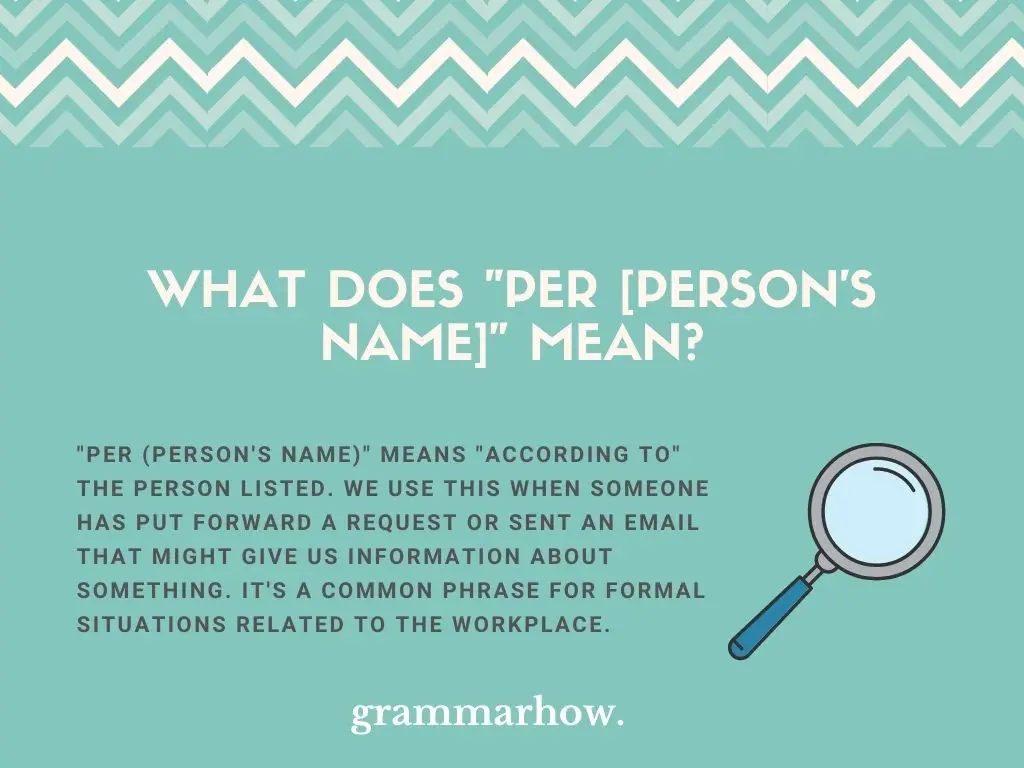When using “per” with a person’s name, it’s important to know what you’re trying to say. This article will explain the correct meaning of the words so that you don’t have to worry about getting them wrong in the future.
What Does “Per [Person’s Name]” Mean?
“Per (person’s name)” means “according to” the person listed. We use this when someone has put forward a request or sent an email that might give us information about something. It’s a common phrase for formal situations related to the workplace.

“Per” comes from the Latin word “per,” which means “on account of.” We use it to show that someone has given us an account or provided information about something. We can use this information to make things easier for us to work out.
It’s also helpful to use “per (person’s name)” when we’re trying to show who our source was. If we aren’t claiming responsibility for the information ourselves, it’s important to show who did it.
It can be as simple as this:
- Per John, we all need to meet in the conference room at five to discuss the plans.
Here, “John” has previously provided us with a request to meet in the conference room. That’s why we say “per John,” as it shows that he’s in control of the situation.
Examples Of How To Use “Per [Person’s Name]” In A Sentence
- Per Martin’s request, you will all need to find a new place to get this work done. You cannot stay in this office.
- Per Tim, it’s important that we all start to merge with the new colleagues. We can’t keep leaving them in the dark.
- It’s time that we started working on the new rules per Sarah. She has asked that we complete the initial draft by sundown.
- I want to say that this is all per Michael. He has given us a lot of information about this, and it’s important that we get it right.
- Per Harriet’s email, we need to start fusing the old company with the new one. It’s important that we get this sorted in time.
- Per Martha, there are some people who still need to be inducted. We need to get this sorted before the auditors arrive tomorrow.
- I think you’ll find that this information is per Jonathan. He has given us all we need to work with to get this right.
“Per (person’s name)” works well when you’re directly referring to the person that gave you a task or information. You can also include a noun after the person’s name, like “request” or “email,” to show the specific source.
Remember, if you include a noun after the name, the name should turn into the possessive form (i.e. “per Sandra’s request”).
Is It Correct To Say “Per [Person’s Name]”?
“Per (person’s name)” is grammatically correct. You don’t have to include anything after it for it to make sense in a sentence. It already addresses the person that you got the information from, and you can continue the sentence just fine after this.
Of course, “per (person’s name)” should never be its own sentence. It is part of a dependent clause, which means it depends on the rest of the sentence to be present for it to be grammatically correct.
- Per Roger, we will get this done.
If we removed the second clause, “Per Roger” would not be a suitable sentence.
Is “Per [Person’s Name]” Formal?
“Per (person’s name)” is formal. It’s common to see it used in many formal situations. Many workplaces use “per” in all forms whenever they want to show the direct source of information provided.
For example, if you speak for your manager, you might want to use “per (manager’s name).” That way, if you’re requesting something from your colleagues that they might not agree with, you can show them that your manager was the one that requested it from them.
It’s a good way to show people where information is coming from. That way, they’ll know whether they should listen to the request or ignore it for the time being.
Other Ways To Say “Per [Person’s Name]”
It might also help to come up with some other ways to say this phrase. One of the following works well:
- Per your/his/her request
- According to
- In accordance with
- As per
- By your/his/her request
When using “per” with a person’s name, it’s important to know what you’re trying to say. This article will explain the correct meaning of the words so that you don’t have to worry about getting them wrong in the future.
What Does “Per [Person’s Name]” Mean?
“Per (person’s name)” means “according to” the person listed. We use this when someone has put forward a request or sent an email that might give us information about something. It’s a common phrase for formal situations related to the workplace.
“Per” comes from the Latin word “per,” which means “on account of.” We use it to show that someone has given us an account or provided information about something. We can use this information to make things easier for us to work out.
It’s also helpful to use “per (person’s name)” when we’re trying to show who our source was. If we aren’t claiming responsibility for the information ourselves, it’s important to show who did it.
It can be as simple as this:
- Per John, we all need to meet in the conference room at five to discuss the plans.
Here, “John” has previously provided us with a request to meet in the conference room. That’s why we say “per John,” as it shows that he’s in control of the situation.
Examples Of How To Use “Per [Person’s Name]” In A Sentence
- Per Martin’s request, you will all need to find a new place to get this work done. You cannot stay in this office.
- Per Tim, it’s important that we all start to merge with the new colleagues. We can’t keep leaving them in the dark.
- It’s time that we started working on the new rules per Sarah. She has asked that we complete the initial draft by sundown.
- I want to say that this is all per Michael. He has given us a lot of information about this, and it’s important that we get it right.
- Per Harriet’s email, we need to start fusing the old company with the new one. It’s important that we get this sorted in time.
- Per Martha, there are some people who still need to be inducted. We need to get this sorted before the auditors arrive tomorrow.
- I think you’ll find that this information is per Jonathan. He has given us all we need to work with to get this right.
“Per (person’s name)” works well when you’re directly referring to the person that gave you a task or information. You can also include a noun after the person’s name, like “request” or “email,” to show the specific source.
Remember, if you include a noun after the name, the name should turn into the possessive form (i.e. “per Sandra’s request”).
Is It Correct To Say “Per [Person’s Name]”?
“Per (person’s name)” is grammatically correct. You don’t have to include anything after it for it to make sense in a sentence. It already addresses the person that you got the information from, and you can continue the sentence just fine after this.
Of course, “per (person’s name)” should never be its own sentence. It is part of a dependent clause, which means it depends on the rest of the sentence to be present for it to be grammatically correct.
- Per Roger, we will get this done.
If we removed the second clause, “Per Roger” would not be a suitable sentence.
Is “Per [Person’s Name]” Formal?
“Per (person’s name)” is formal. It’s common to see it used in many formal situations. Many workplaces use “per” in all forms whenever they want to show the direct source of information provided.
For example, if you speak for your manager, you might want to use “per (manager’s name).” That way, if you’re requesting something from your colleagues that they might not agree with, you can show them that your manager was the one that requested it from them.
It’s a good way to show people where information is coming from. That way, they’ll know whether they should listen to the request or ignore it for the time being.
Other Ways To Say “Per [Person’s Name]”
It might also help to come up with some other ways to say this phrase. One of the following works well:
- Per your/his/her request
- According to
- In accordance with
- As per
- By your/his/her request
You may also like:
“As Per” vs. “Per” – Easy Usage Guide (Helpful Examples)
“Per” vs. “According To” – Difference Explained (Helpful Examples)
“As per your request” meaning: 4 examples of how to use it in a sentence
Per Usual – Meaning & Usage (10+ EXAMPLES)
10 Better Ways To Say “As Per Our Conversation”

Martin holds a Master’s degree in Finance and International Business. He has six years of experience in professional communication with clients, executives, and colleagues. Furthermore, he has teaching experience from Aarhus University. Martin has been featured as an expert in communication and teaching on Forbes and Shopify. Read more about Martin here.
